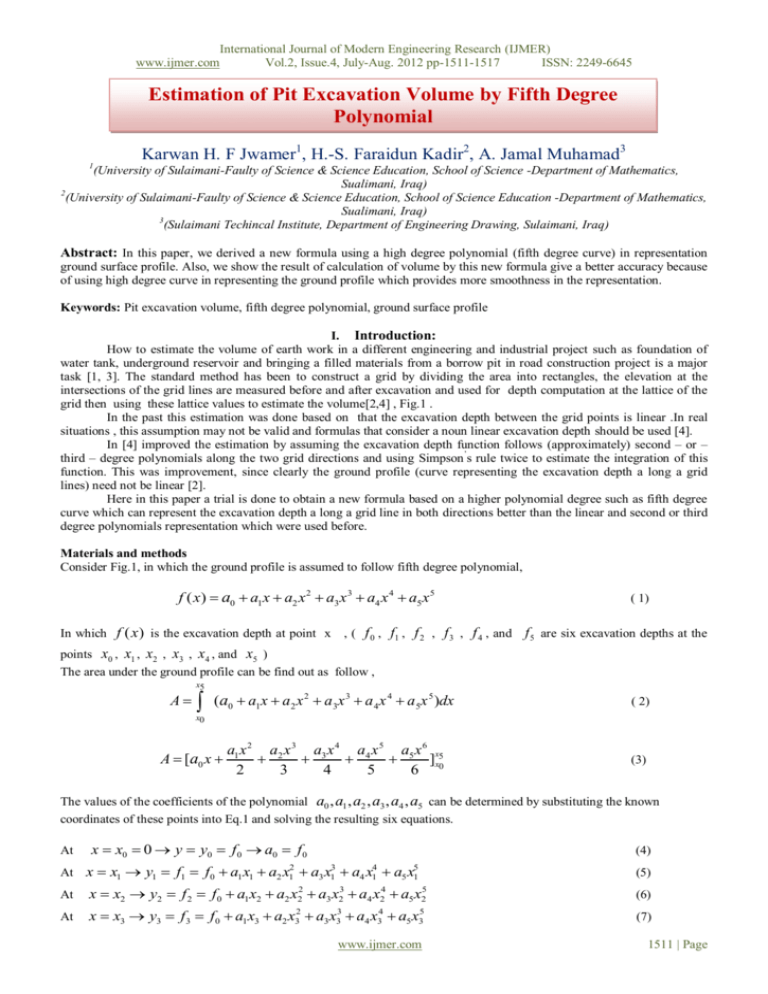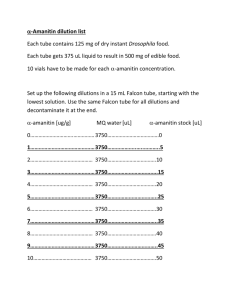
www.ijmer.com
International Journal of Modern Engineering Research (IJMER)
Vol.2, Issue.4, July-Aug. 2012 pp-1511-1517
ISSN: 2249-6645
Estimation of Pit Excavation Volume by Fifth Degree
Polynomial
Karwan H. F Jwamer1, H.-S. Faraidun Kadir2, A. Jamal Muhamad3
1
(University of Sulaimani-Faulty of Science & Science Education, School of Science -Department of Mathematics,
Sualimani, Iraq)
2
(University of Sulaimani-Faulty of Science & Science Education, School of Science Education -Department of Mathematics,
Sualimani, Iraq)
3
(Sulaimani Techincal Institute, Department of Engineering Drawing, Sulaimani, Iraq)
Abstract: In this paper, we derived a new formula using a high degree polynomial (fifth degree curve) in representation
ground surface profile. Also, we show the result of calculation of volume by this new formula give a better accuracy because
of using high degree curve in representing the ground profile which provides more smoothness in the representation.
Keywords: Pit excavation volume, fifth degree polynomial, ground surface profile
I. Introduction:
How to estimate the volume of earth work in a different engineering and industrial project such as foundation of
water tank, underground reservoir and bringing a filled materials from a borrow pit in road construction project is a major
task [1, 3]. The standard method has been to construct a grid by dividing the area into rectangles, the elevation at the
intersections of the grid lines are measured before and after excavation and used for depth computation at the lattice of the
grid then using these lattice values to estimate the volume[2,4] , Fig.1 .
In the past this estimation was done based on that the excavation depth between the grid points is linear .In real
situations , this assumption may not be valid and formulas that consider a noun linear excavation depth should be used [4].
In [4] improved the estimation by assuming the excavation depth function follows (approximately) second – or –
third – degree polynomials along the two grid directions and using Simpson’s rule twice to estimate the integration of this
function. This was improvement, since clearly the ground profile (curve representing the excavation depth a long a grid
lines) need not be linear [2].
Here in this paper a trial is done to obtain a new formula based on a higher polynomial degree such as fifth degree
curve which can represent the excavation depth a long a grid line in both directions better than the linear and second or third
degree polynomials representation which were used before.
Materials and methods
Consider Fig.1, in which the ground profile is assumed to follow fifth degree polynomial,
f ( x) a0 a1 x a2 x 2 a3 x 3 a4 x 4 a5 x 5
In which f ( x ) is the excavation depth at point x , ( f 0 , f1 , f 2 , f 3 , f 4 , and
( 1)
f 5 are six excavation depths at the
points x0 , x1 , x2 , x3 , x4 , and x5 )
The area under the ground profile can be find out as follow ,
A
x5
(a0 a1x a2 x 2 a3x 3 a 4 x 4 a 5x 5 )dx
( 2)
a1 x 2 a2 x 3 a3 x 4 a4 x 5 a5 x 6 x5
]x
2
3
4
5
6 0
(3)
x0
A [a0 x
The values of the coefficients of the polynomial a0 , a1 , a2 , a3 , a4 , a5 can be determined by substituting the known
coordinates of these points into Eq.1 and solving the resulting six equations.
At
x x0 0 y y0 f 0 a0 f 0
(4)
At x x1 y1 f1 f0 a1 x1 a2 x1 a3 x1 a4 x1 a5 x1
(5)
At
x x2 y2 f 2 f 0 a1 x2 a x a x a x a x
(6)
At
x x3 y3 f 3 f 0 a1 x3 a x a x a x a x
(7)
2
2
2 2
2
2 3
3
4
3
3 2
3
3 3
4
4 2
4
4 3
5
5
5 2
5
5 3
www.ijmer.com
1511 | Page
www.ijmer.com
International Journal of Modern Engineering Research (IJMER)
Vol.2, Issue.4, July-Aug. 2012 pp-1511-1517
ISSN: 2249-6645
At
x x4 y4 f 4 f 0 a1 x4 a2 x42 a3 x43 a4 x44 a5 x45
(8)
At
x x5 y5 f5 f 0 a1 x5 a x a x a x a x
(9)
2
2 5
3
3 5
4
4 5
5
5 5
Because of using equal intervals, this led to say that
h x1 x0 : 2h x2 x0 : 3h x3 x0 : 4h x4 x0 : 5h x5 x0
Solving equation 5,6,7,8 and 9 give the values of coefficients
a1 , a2 , a3 , a4 , and a5 as follow ,
a1
1
[137f 0 300f 1 300f 2 200f 3 75f 4 12f 5 ]
60h
a2
1
[45f 0 154f 1 214f 2 156f 3 61f 4 10f 5 ]
24h 2
1
[17f 0 71f 1 118f 2 98f 3 41f 4 7f 5 ]
24h 3
1
a4
[3f 0 14f 1 26f 2 24f 3 11f 4 2f 5 ]
24h 4
a3
a5
1
[f 0 5f 1 10f 2 10f 3 5f 4 f 5 ]
120h 5
Substituting for a0 , a1 , a2 , a3 , a4 , a5 in equation 3 and noting that x0 0 and x5 5h , this yields the following
formula for calculating area under the curve,
Area
5h
[19 f 0 75 f1 50 f 2 50 f 3 75 f 4 19 f 5 ]
288
(10)
Now to calculate volume take a unit grid of 5*5 of equal intervals in both direction as in Fig.2 , the volume of this unit grid
is given by
volume
x5
x0
y5
y0
f ( x, y )dydx
(11)
Where f ( x , y ) is a depth of excavation at grid nodes
First, the inner integral is calculated using the results in Eq. 10,
x
5h 5
v
[ 19 f ( x, y0 ) 75 f ( x, y1 ) 50 f ( x, y2 ) 50 f ( x, y3 ) 75 f ( x, y4 ) 19 f ( x, y5 )]dx
288 x0
v
x5
x5
x5
x5
x5
x5
5h
[19 f ( x , y0 )dx 75 f ( x , y1 )dx 50 f ( x , y2 )dx 50 f ( x , y3 )dx 75 f ( x , y4 )dx 19 f ( x , y5 )dx ]
288
x0
x0
x0
x0
x0
x0
(12)
(13)
use the results in equation number 10 again to each integral term in Eq.13 to obtained ,
v(
25h 2
) *
1440 ij
Where
f
(14)
ij
ij are the corresponding elements of the following matrix :
www.ijmer.com
1512 | Page
www.ijmer.com
361
1425
950
C
950
1425
361
And
f
ij
International Journal of Modern Engineering Research (IJMER)
Vol.2, Issue.4, July-Aug. 2012 pp-1511-1517
ISSN: 2249-6645
1425 950 950 1425 361
5625 3750 3750 5625 1425
3750 2500 2500 3750 950
3750 2500 2500 3750 950
5625 3750 3750 5625 1425
1425 950 950 1425 361
are the corresponding elements of the following matrix which represent depth of excavation at
Grid nodes
f 0,5
f 0,4
f 0,3
F
f 0,2
f 0,1
f 0,0
f 1,5
f 1,4
f 1,3
f 1,2
f 1,1
f 1,0
f 2,5 f 3,5
f 2,4 f 3,4
f 2,3 f 3,3
f 2,2 f 3,2
f 2,1 f 3,1
f 2,0 f 3,0
f 4,5
f 4,4
f 4,3
f 4,2
f 4,1
f 4,0
f 5,5
f 5,4
f 5,3
f 5,2
f 5,1
f 5,0
Equation 14 is a single formula for volume calculation for a grid unit of 5*5 of equal intervals in both directions in terms of
the intersection points.
To calculate the total volume of any grid capacity which must be multiple of 5 in both direction is the sum of volumes of
the unit grids . To calculate total volume let,
xi x0 ih ; i=0,1 , …….. m.
y j y0 jh; j=0,1,……….n.
Then the composite formula for calculating the volume of the total grid, V, is given by ,
V
xm
x0
V (
yn
y0
f ( x, y )dydx
25h 2 m
)
1440 i 0
In which
n
ij fij
(Composite formula)
(15)
j 0
ij =the corresponding elements of the following matrix
www.ijmer.com
1513 | Page
www.ijmer.com
C
361
1425
950
950
1425
722
1425
.
.
1425
722
1425
950
950
1425
361
International Journal of Modern Engineering Research (IJMER)
Vol.2, Issue.4, July-Aug. 2012 pp-1511-1517
ISSN: 2249-6645
1425
950
950
1425
722
1425
.
.
1425
722
1425
950
950
1425
5626
3750
3750
5625
2850
5625
.
.
5625
2850
5625
3750
3750
5625
3750
2500
2500
3750
1900
3750
.
.
3750
1900
3750
2500
2500
3750
3750
2500
2500
3750
1900
3750
.
.
3750
1900
3750
2500
2500
3750
5625
3750
3750
5625
2850
5625
.
.
5625
2850
5625
3750
3750
5625
2850
1900
1900
2850
1444
2850
.
.
2850
1444
2850
1900
1900
2850
5625
3750
3750
5625
2850
5625
.
.
5625
5625
5625
3750
3750
5625
.
.
.
.
.
.
.
.
.
.
.
.
.
.
.
.
.
.
.
.
.
.
.
.
.
.
.
.
5625
3750
3750
5625
2850
5625
.
.
5625
5625
5625
3750
3750
5625
2850
1900
1900
2850
1444
2850
.
.
2850
2850
2850
1900
1900
2850
5625
3750
3750
5625
2850
5625
.
.
5625
5625
5625
3750
3750
5625
3750
2500
2500
3750
1900
3750
.
.
3750
3750
3750
2500
2500
3750
3750
2500
2500
3750
1900
3750
.
.
3750
3750
3750
2500
2500
3750
5625
3750
3750
5625
2850
5625
.
.
5625
5625
5625
3750
3750
5625
1425
950
950
1425
722
1425
.
.
1425
1425
1425
950
950
1425
1425
950
950
1425
722
1425
.
..
.
1425
722
1425
950
950
1425
361
361
f i , j Depth of grid point with coordinates ( xi , yi )
The matrix of Eq.15 corresponds to the grid points in Fig.3. This with the note that the second , third , fourth and fifth
columns are to be repeated , as well as the second , third , fourth and fifth rows) . This, to calculate V, we only need to
multiply each depth f i , j by the corresponding elements and sum the results for all points. The elements of the matrix C can
be implemented easily in a computer program because they exhibit a specific pattern.
Eq.15 is for square grid with equal interval in both direction, if the gird is rectangular grid with h distance between grid
nodes in x direction and with k distance in y direction, the equation became,
V (
m
25 2
) *h *k
1440
i 0
n
ij fij
Composite equations for rectangle grid
(16)
j 0
NUMERICAL EXAMPLE:
Consider the unit grid of Fig.4, in which m=1, n=1, h = 10 m. The excavation depths (in meter) are shown beside the
grid intersection points, let to calculate the volume as follow;A) Classical method which is based on a linear relationship between the depth ends which represent the earth surface in both
direction,
V [3]
Where
As
( h1 2 h2 3 h3 4 h4 )
4
h
1
= sum of depth used once
2 h2 = sum of depth used twice
3 h3 = sum of depth used thrice
4 h4 = sum of depth used four times
As= area of one square in a grid
www.ijmer.com
1514 | Page
www.ijmer.com
International Journal of Modern Engineering Research (IJMER)
Vol.2, Issue.4, July-Aug. 2012 pp-1511-1517
ISSN: 2249-6645
h = 0.70 + 0.14 + 1.30 + 1.0 = 3.14 m.
1
2
h
2
= 2( 1.10+1.32+0.87+0.25 + 1.14+2.14+1.69+0.45 + 1.4+1.35+0.89+0.75 +1.25+2.09+0.79+0.75)=36.46 m.
3 h3 =0
4 h4 =4(2.17+1.25+0.98+0.18+3.12+2.92+1.75+1.55+1.75+2.03+0.99+1.35+1.69+1.10+1.62+2.11)= 106.24m.
Volume =
100
3
( 3.14+36.46+106.24)= 3646 m
4
B) Volume calculation based on the obtained equation 15,
volume (
25h 2 m
)
1440 i 0
361
1425
25*10 2 950
V= (
)
1440 950
1425
361
3
Volume = 3710.743 m
ij f ij
n
j 0
1425 950 950 1425 361
0.70
5625 3750 3750 5625 1425
1.14
2.14
3750 2500 2500 3750 950
*
3750 2500 2500 3750 950
1.69
0.45
5625 3750 3750 5625 1425
1425 950 950 1425 361
1.00
0.14
1.25
2.09
0.79
1.65 1.10 1.62 2.11 0.75
1.40 1.35 0.89 0.75 1.30
1.10
2.17
3.12
1.75
1.32
1.25
2.92
2.03
0.87
0.98
1.75
0.99
0.25
0.18
1.55
1.35
II. Conclusions
1)
2)
3)
4)
the obtained formula for volume computation here on this paper is based on the assumption that the ground profile is
nonlinear with fifth –degree polynomials
the obtained formula of course provide a better accuracy than formula that assumes a linear or second, or third-degree
polynomials
the limitation here is that the grid must be equal to the interval in both direction and total number of interval must be
equal to 5 or multiple of five
using this formula need computer programming
Notation:A
As
a0 , a1, a2 , a3 , a4 , a5
C
= area of region with irregular boundary
= area of a single square in a used grid
= coefficients of used fifth –degree polynomial
= matrix of elements
= width of increment in x- direction
= width of increment in y-direction
dx
dy
f 0 , f1 , f 2 , f 3 , f 4 , and f 5 = six excavation depths at the points
x0 , x1 , x2 , x3 , x4 , and x5 )
= depth of grid point with coordinates ( xi , y j )
fi, j
= depth of point at horizontal distance x
f ( x)
f ( x, y ) = depth of point with coordinates ( x , y )
h
=
distance between grid points in both x and y direction in the case of square grid
www.ijmer.com
1515 | Page
www.ijmer.com
h1
h2
h3
h4
i
j
k
m
n
V
v
ij
International Journal of Modern Engineering Research (IJMER)
Vol.2, Issue.4, July-Aug. 2012 pp-1511-1517
ISSN: 2249-6645
= depth used once
=
=
=
=
=
=
=
=
=
=
depth used twice
depth used thrice
depth used four times
index for grid points in x-direction
index for grid points in y-direction
distance between grid points in y direction in the case of rectangle grid
number of grid intervals in x- direction
number of grid intervals in y-direction
volume of total grid
volume of unit grid of 5*5 equal intervals
= the corresponding elements of the following matrix C
References
[1]
Barry Kavanagh, 2009, Surveying – Priniples and Application, Eighth Edition, Pearson Prentice Hall.
[2]
Danial W. Chambers , Estimating Pit Excavation Volume Using Unequal Interval , Journal of Surveying Engineering ,
Vol. 115 , No.4, November , 1989 , p 390-401.
[3]
S.K.Roy, 2004, Fundamentals of Surveying , Prentice-Hall of India, New Delhi .
[4]
Said M. Easa, Estimating Pit Excavation Volume Using Nonlinear Ground Profile, Journal of Surveying Engineering,
Vol.114, No. 2, May, 1988 p 71-83
Y f ( x ) a0 a1 x a 2 x 2 a3 x3 a4 x4 a5 x5
www.ijmer.com
1516 | Page
www.ijmer.com
International Journal of Modern Engineering Research (IJMER)
Vol.2, Issue.4, July-Aug. 2012 pp-1511-1517
ISSN: 2249-6645
www.ijmer.com
1517 | Page







